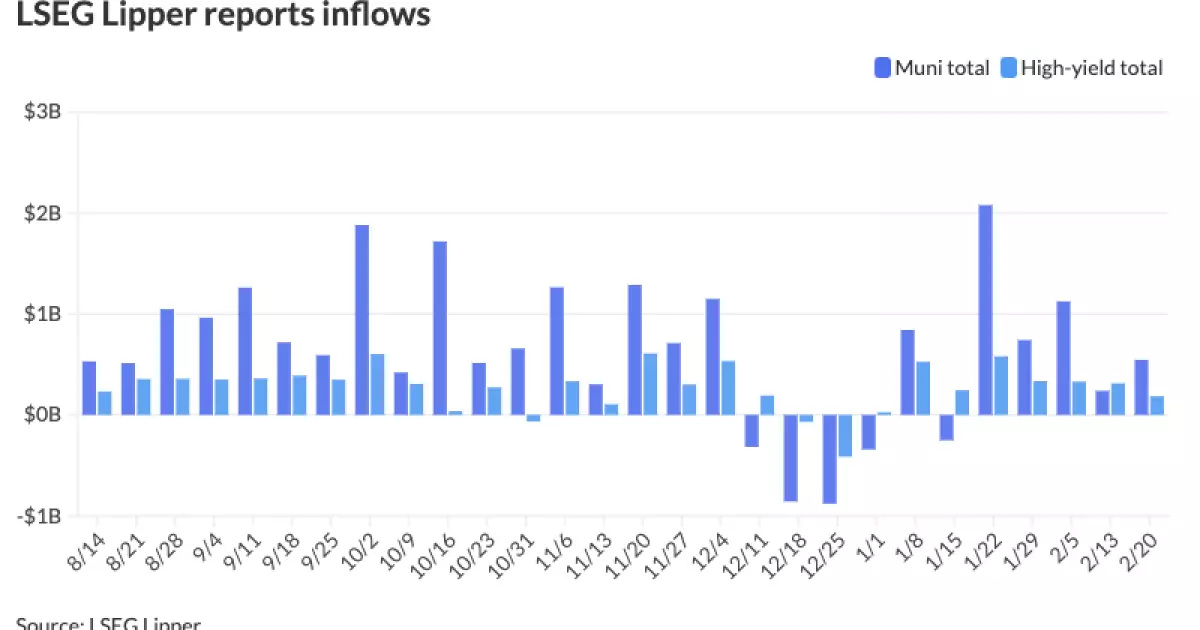In the current climate, the municipal bond market is displaying a degree of stability, with recent pricing activities suggesting a slightly firmer atmosphere. A noteworthy driver of this trend was the pricing of the $2.5 billion Brightline West Passenger Rail Project deal, which emerged amidst a relatively subdued environment for new issues. This occurrence reflects a broader context where U.S. Treasury yields have experienced slight declines alongside dropping equity values. Detailed analysis from the Municipal Market Data revealed that the two-year municipal to UST ratios remained steady, indicative of the market’s cautious optimism continuing despite fluctuations in economic narratives.
James Pruskowski, the chief investment officer at 16Rock Asset Management, remarked on the recent volatility observed in January, where tariff-related inflation concerns caused the 10-year UST yield to reach peaks of 4.80%, although ultimately stabilizing at 4.54%. This oscillation in yields underscores the market’s response to evolving macroeconomic narratives, particularly concerning advancements in the AI sector and government revenue projections which play a pivotal role in shaping investor sentiment.
Strategists from J.P. Morgan have identified the present week as favorable for the tax-exempt market due to the previous week’s underperformance and the anticipated arrival of significant reinvestment capital. They predict that the combined factors of an $18 billion influx of reinvestment capital accompanied by low supply levels—only $4.3 billion for the week—could provide a potent backdrop for investments. Fund flows, which have been largely positive, are expected to further bolster the market, particularly as interest rates remain within a manageable range, fostering a supportive environment for municipal investors.
However, there looms the potential for volatility as the market navigates closer to the March-May period, when reinvestment capital dwindles and supply pressures could surge. It’s crucial for investors to be cognizant of these shifting dynamics, which may present opportunities to acquire assets at more favorable pricing. The current landscape suggests that while absolute yields on long-dated high-grade municipals appear attractive relative to their historical norms, investors should remain vigilant in anticipating fluctuations resulting from evolving market conditions.
Recent primary market developments indicate robust issuance activity, particularly highlighted by transactions involving unique projects such as the Brightline West Passenger Rail. For instance, Morgan Stanley’s pricing of $2 billion in non-rated green revenue bonds reflects a growing trend towards sustainable infrastructure financing. This aligns with a broader institutional strategy to integrate environmental, social, and governance (ESG) considerations into investment decisions, confirming that ethical considerations are shaping financing structures in the municipal bond landscape.
Additionally, other significant bond deals—such as airport revenue bonds issued for Miami-Dade County and revenue bonds for educational facilities in Wisconsin—illustrate the diverse applications of bond financing. These issuances not only bolster the infrastructure and development goals of municipalities but also present investors with varied portfolio options aimed at meeting risk and return preferences.
Investor sentiment has been visibly buoyed by recent inflows into municipal bond mutual funds, with an increase of $546.3 million documented in the week ending Wednesday. This comes in stark contrast to the previous week’s inflows, suggesting a growing confidence among investors in the resilience of the municipal bond sector. Additionally, high-yield funds remain desirable, attracting substantial capital even amidst minor attrition in tax-exempt municipal money market funds.
Market dynamics are further nuanced by yield fluctuations at AAA scales, with recent adjustments indicating slight increases across various maturities. This positioning suggests that while investor appetite remains strong, there is a delicate balancing act as the market seeks to maintain attractive yields while mitigating risks associated with rising interest rates and inflationary pressures.
As we enter the second quarter of the year, investors should consider strategic positioning in anticipation of potential market volatility. The expectation for lower rates by 2025 could influence decision-making, especially in the context of long-term investing. Stakeholders will need to evaluate individual portfolios carefully and weigh the timing of investment decisions against the potential for forthcoming market shifts.
The municipal bond market is currently marked by intriguing developments, characterized by steady demand, strategic issuances, and the interplay of various economic factors. Awareness and adaptability in strategy will be critical as this market evolves amidst changing conditions, especially considering the larger macroeconomic environment that continues to influence municipal financing prospects.

